

The Burgh Inclusive
Editor-in-Chief: Samantha Hindman
Managing Editor: Brandon Kurzawski
Art Director: Alexa Shaulis
Graphic Designer: Hannah Bond
Contributing Writers:
ISSN 2836-1660 | Fall 2022
Hannah Bond, Samantha Hindman, Brandon Kurzawski, Delaney Mackey, Alexa Shaulis, Sarah Watkins, Rain Yao, Dylann Yarrington
WON’T YOU BE MY NEIGHBOR: A Look into the Culture of Pittsburgh Neighborhoods
By Sarah WatkinsPittsburgh prides itself on having 90 neighborhoods filled with history, culture and customs.
WHAT IS THE FUTURE OF PUBLIC TRANSIT IN PITTSBURGH?
By Brandon KurzawskiA 25-year plan called NEXTransit promises dedicated bus lanes and better integration with the existing regional transit providers.
LIGHT UP NIGHT BRINGS PITTSBURGH FAMILIES TOGETHER
By Hannah BondThe city’s 61st annual Light Up Night brings thousands to Pittsburgh’s downtown.
PITTSBURGH AND DANCE
By Delaney MackeyFrom Martha Graham to Gene Kelly, the Burgh has a remarkable legacy of dance which lives on today.
FINDING COMMUNITY IN AMAZING BOOKS AND RECORDS
By Alexa ShaulisEric Ackland’s indie bookstore is more than books and records, it’s a community hub.
PITTSBURGH BREWS
By Samantha HindmanThe hustle and bustle that people experience in everyday city life can all trace to one common remedy: a cup of coffee.
DOWNTOWN PITTSBURGH BY THE SLICE
By Dylann YarringtonFind out where you can enjoy a good slice of pizza in Pittsburgh’s downtown.
MR. KOVACH
By Rain YaoShort Story Debut.
From the Editor
IAM incredibly excited to introduce an inaugural edition of The Burgh Inclusive, a student magazine about Pittsburgh, its history, traditions, places, culture and most of all, its people. True Yinzers affectionally call their beloved city simply the Burgh which explains this choice for our magazine title. It is also known as the Steel City, built by the blood and sweat of migrant Americans and by immigrants from all over the world, something that we will forever honor.
One may start by explaining why there is a need for another magazine about Pittsburgh. The answer is simple, every new generation rediscovers America’s biggest small town and post-Millennials are not an exception. We want to use this magazine as an opportunity to show people what Pittsburgh looks like through the lens of the city’s youth.
The Burgh Inclusive originated as a class project in the “Introduction to Multimedia” course taught by professor Tatyana Dumova in the Fall of 2022 in the School of Communication at Point Park University. We collaborated to create something that is meaningful, impactful and most importantly—fun!
Pittsburgh prides itself on having 90 distinct neighborhoods and the magazine opens with a feature presenting three of them—Bloomfield, Strip District and Hill District—with each carrying a lot of history and traditions. In the summer of 2022, Pittsburgh’s public transportation system was rebranded along with unveiling bold plans for the future and the next story deals with it. One of the most cherished Pittsburgh family traditions is its annual Light Up Night and it is reflected in the magazine’s content. Pittsburgh is considered one of the cultural capitals of America. It is the birthplace of many prominent performing artists and the next piece highlights
Martha Graham and Gene Kelly who both had a profound impact on modern dance. One of the biggest Carnegie libraries is in Pittsburgh, symbolizing that it is the city of book readers. It takes both a love for books and community to run a brick-and-mortar bookstore in the digital age and here is a story about one in Pittsburgh. Every American metropolis boasts that it offers the most robust cup of coffee and the most nourishing slice of pizza. It’s hard to judge but one may claim that Pittsburgh has it all.
The magazine concludes with a short story debut by an aspiring writer from the “Diversity and Communication” class. It tells a story about two neighbors playing the Monopoly board game. The author doesn’t say where they live but there are some clues. One of the two main characters bears a last name that means blacksmith in Hungarian and Pittsburgh is known as the Steel City. Another hint, recently Monopoly attracted everybody’s attention when a Pittsburgh-themed edition of this popular game was issued. But the main key can be found in the ending of the story which elevates and celebrates friendship above all. And this is really Pittsburghers’ trait.
The editor is thankful to the editorial team, as well as of our all contributing authors. But especially, I am grateful to professor Dumova for her hard work. Without her consistent care and dedication to the success of her students, this magazine simply would not have been possible. I speak for our entire team when I say that she is an inspiring and admirable instructor.
We sincerely hope you enjoy reading this magazine and wish you to admire our Steel City as strongly as we do!
Samantha Hindman Editor-in-Chief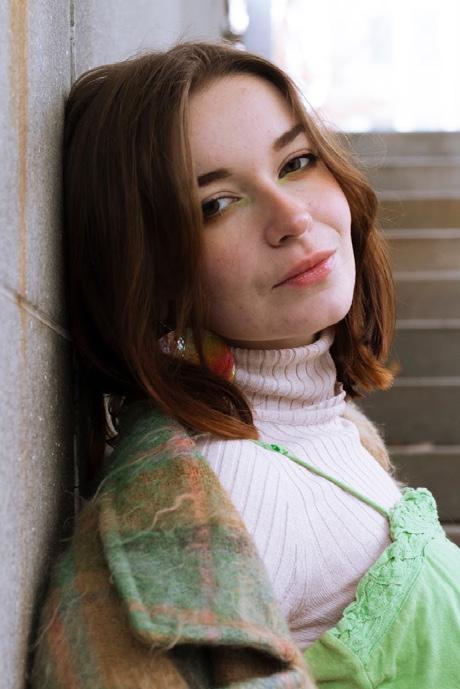
Community / WON’T YOU BE MY NEIGHBOR: A LOOK INTO THE CULTURE OF PITTSBURGH NEIGHBORHOODS

A s Mr. Rogers once asked the nation, Pittsburghers are asking too.
By Sarah Watkins Public relations and advertising majorDURING THE 19TH CENTURY, Pittsburgh transformed into a bustling, industrial city with many different cultures. The nation’s number one steel producer first attracted migrants from rural America. Then immigrant workers arrived from all over the world. They came to make a better life hoping to live the American Dream. These were Germans, Irish, Italians, Serbs, Croatians, Slovaks, Hungarians, Carpatho-Russians, Poles, Greeks and Slovenians, to name the major ethnic groups that settled in the Steel City. Pittsburgh provided a safe harbor for African Americans during the Civil War and the Great Northward Migration.
It does not surprise anyone that Pittsburgh prides itself on having 90 distinct neighborhoods filled with intense history, culture and customs. Edge to edge, they are colored with the knowledge and traditions of generations of Yinzers. Here is a look at three of the neighborhoods.

BLOOMFIELD
Bloomfield is located on Pittsburgh’s East End. The Steel City called it its own in 1868 and it was settled by German and Irish immigrants. Later came Italian immigrants who gave the neighborhood its current unofficial nickname “Little Italy.”

Today Bloomfield borders Oakland, Shadyside, Friendship, Garfield and Lawrenceville, full of their own ethnic and cultural history.
Every summer Bloomfield celebrates Little Italy Days on its main drag, Liberty Avenue, and thousands attend this street heritage festival.
Located at the intersection of Liberty and Cedarville streets is Merante’s storefront filled with authentic Italian cuisine, ingredients and more. Here you can order a take-out dinner, or even a whole cookie table, a storied Pittsburgh wedding tradition.
After you have done a little shopping, make sure to stop over to Tessaro’s on Liberty for a quick bite. For over 25 years, the local fast food joint has been serving up half-pound ground chuck burgers that one would be able to smell all the way down the block.
Tessaro’s butcher grinds out the meat inhouse to make sure the customer is getting the most authentic experience. The building itself dated to 1892. Since then, it has been handed down through generations and has gone through many transitions.
If you find yourself as more of a nightlife person, head down to the Pleasure Bar on Liberty, which serves up authentic Italian cuisine. Opened in 1941, the bar has been passed through three families. In the 1960s, it was a very frequent spot for members of the Pittsburgh Hornets, then a minor league ice hockey team, which made it a big attraction.
STRIP DISTRICT
If you are looking for something a little grittier, look no further than the Strip District. In the 1820s and 1830s, this area, roughly 4 by 20 blocks, saw an industrial boom and iron foundries, steel mills, glass factories and railroad yards were built. Territorial shortage prevented industrial companies from expanding and most of them left the Strip one by one.
The 1900s gave way to the fruit and vegetable wholesaling industry that took advantage of the developed railroad network. In 1926, a quarter-mile long Pennsylvania Fruit Auction and Sales Building, or simply the Produce Terminal, was constructed. This state of the art rail-to-truck transloading facility allowed for fast unloading freight trains from Florida and California and complimented the already existing produce warehouses and auction companies. The Strip
turned into a tri-state produce distribution hub. Seventy-one produce dealers were around in the 1950s, but this number slowly dwindled down after wholesalers switched from railroads to the trucking industry. The recent rehabilitation of the Produce Terminal into a modern food and retail space signaled a new phase in the life of the Strip District neighborhood, which in 2014 was put on the National Register of Historic Places maintained by the National Park Service.
Looking for a bit of history? Check out the Heinz History Center located on Smallman Street, Pennsylvania’s topmost history museum and affiliate of the Smithsonian Institution. It is operated by the Historical Society of Western Pennsylvania, which itself started out in 1879 as a way to preserve local history. The society relocated its treasures to the Strip District in 1996 and just four years later the center became a Smithsonian affiliate. The Heinz History Center, the largest history museum in Pennsylvania, has been home to hundreds of great exhibits including Mr. Rogers Neighborhood and the history of the Heinz ketchup brand. It is an all-encompassing historical experience of the Steel City.
For the most iconic bite of Pittsburgh, you can visit the original
Primanti Brothers location. Right on 18th street, what once was a sandwich cart turned into a full restaurant founded in 1933. Its “almost famous” sandwich is so special because of the addition of fries and coleslaw that made it easier for truck drivers to eat their sandwiches on the go.
For a deep-rooted Strip District experience, it is better to take a leisurely stroll past its many food-and-goods offerings and then visit Wholey’s meat and fish market. Founded in 1912, it was originally a live poultry and meat company. The store was located in the old Diamond Market, now Market Square in the Downtown, but then moved to its current location in 1959. Fish and seafood were added, coming from New England, the Caribbean and Alaska. In 1988, the brand opened an international division that shipped produce worldwide. Wholey’s holds many community events, such as Oysterfest, to maintain a bond with its customers. Overall, the Strip has many more restaurants, shops, cafes and historical spaces that you may need more than one day to visit all that it can offer.
HILL DISTRICT
Separated from the Strip by a steep hillside above the Pennsylvania Railroad tracks, the Hill District is an axis

of African American culture within Pittsburgh. It had acquired different nicknames through its history, such as Little Harlem and Little Haiti, until it came to be known as “the crossroads of the world” in the 1930-1950s.
The neighborhood really blossomed during the Jazz Age when African American musicians created a vibrant culture there, attracting many jazz connoisseurs to the neighborhood’s clubs.
The New Granada Theater is a prominent feature of the renaissance of the Hill. It was built in 1928 and in the late 1930s it doubled as a jazz club as well as a movie theater. Big stars like Ella Fitzgerald and Duke Ellington performed there.
The theater eventually became abandoned but the Hill Community Development Corp started renovating the New Granada Square in the summer of 2021.

The construction of what now is PPG Paints Arena caused an economic collapse in the Hill. Its predecessor, the Civic Auditorium with a mind-boggling for its time stainless steel domed retractable roof to be used by the Pittsburgh Civic Light Opera, was built in 1961. It went through several renamings, first as Civic Arena and then Mellon Arena, and was affectionately called by Pittsburghers simply as “The Igloo.” The Mellon Arena was home to the
AHL team, the Pittsburgh Hornets. In 1967 they became to be the NHL’s Pittsburgh Penguins and currently play at the PPG Paints Arena.
Top: Playwright August Wilson put Pittsburgh on the literary map of the United States by setting his plays in the Hill. A detail from the Hill District wall mural dedicated to August Wilson.
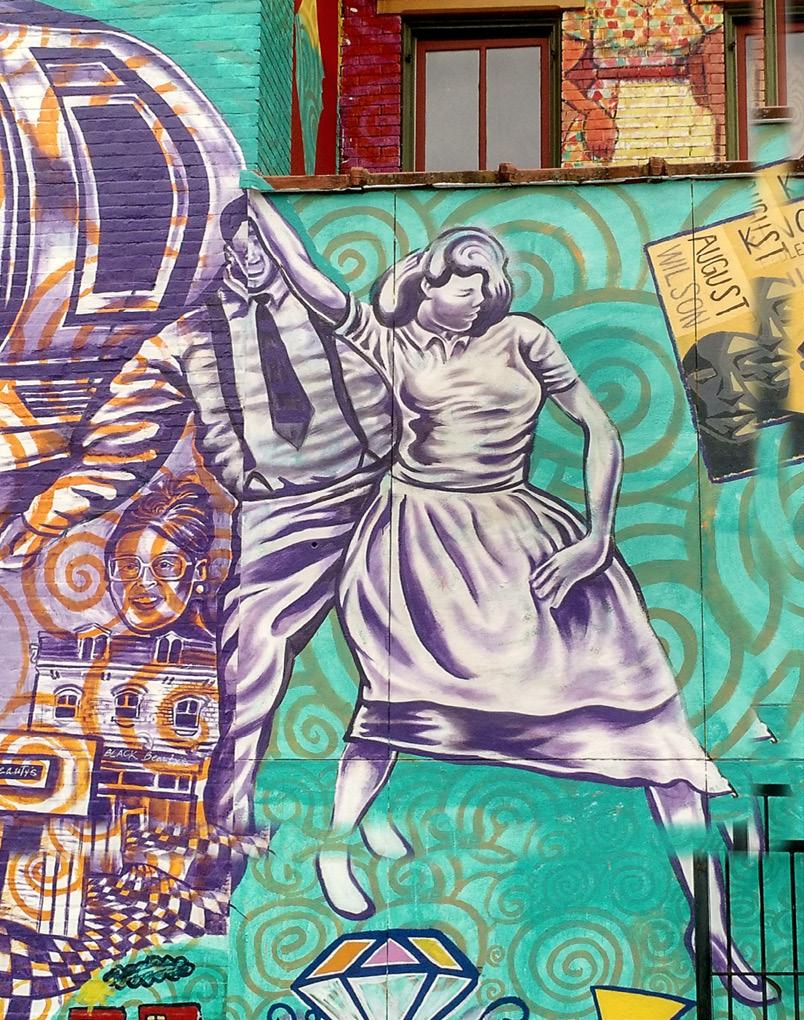
away, the August Wilson Center for African American Culture was opened in downtown Pittsburgh. It contains Wilson’s museum, art galleries and a performing arts theater. The two-story architectural marvel is a place for the voices of creative, Black youths in Pittsburgh.

The Hill District, which was a culturally vibrant area in the first half of the 20th century, paved the way for the flourishing arts scene that we have now in Pittsburgh.
The Hill District is the birthplace of noted American playwright August Wilson. His most popular works are ten plays known as the Pittsburgh Cycle and placed in different decades, with the Hill as the setting for nine of them.
After the playwright passed
In essence, today’s Pittsburgh is a culmination of hard work of many generations of Americans, both native born and immigrants, with rich ethnic and cultural tapestry and deep artistic traditions. Each neighborhood throughout the Burgh, as it is warmly called, holds its own stories with their own hole-inthe-wall spots and historical relevance. Yet, each neighborhood comes together to create a puzzle of heritage shared by each and every person who has lived within the city.
assassination of
painting the
catalystof
culturaland
socialchange. On left: Protest march on April 7, 1968 from Hill District to Downtown three days after the Dr. Martin Luther King, Jr., photo by Charles R. “Chuck” Martin. On right: People taking turns in Pittsburgh Hope Mural in the Hill District in September 2008.
Transportation / WHAT IS THE FUTURE OF PUBLIC TRANSIT IN PITTSBURGH?
A 25-year plan has been introduced called NEXTransit. Riders have already begun to see these changes.
By Brandon Kurzawski Broadcasting majorOVER THE summer of 2022, the Port Authority of Allegheny County (PAT) rebranded to Pittsburgh Regional Transit (PRT). While the name has changed, there is much more to come for the agency.
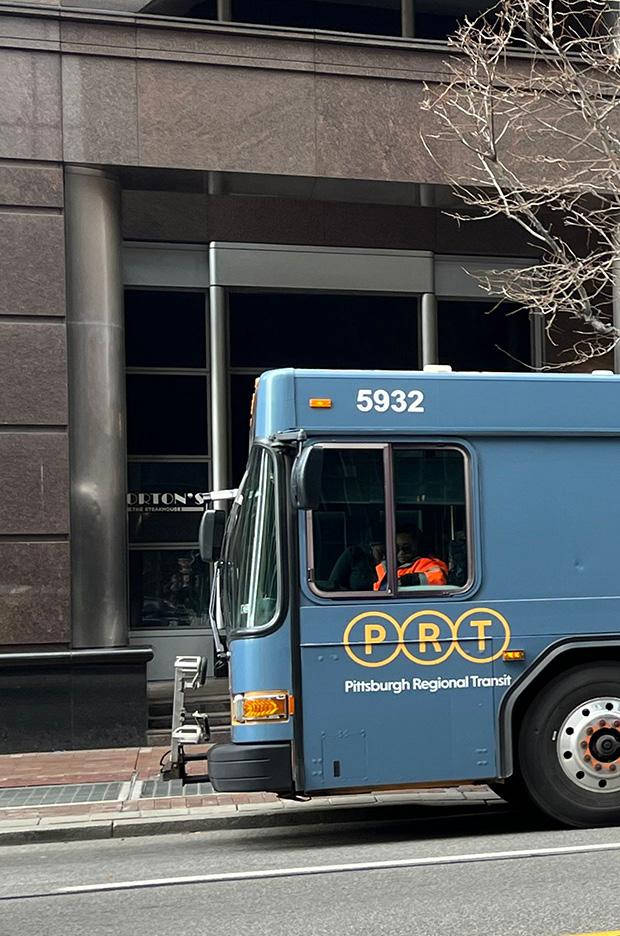
Along with the new designation, a plan was presented to the public called NEXTransit. Over the coming 25 years, the agency intends to re-envision the Pittsburgh public transportation.
The changes kicked off with the Downtown-Uptown-Oakland-East End bus-based rapid transit project or BRT. It is anticipated that this improvement would bring commuters from East End neighborhoods to Central Business District in downtown Pittsburgh at a faster rate. On November 9, 2022, a ground-breaking ceremony was held in Oakland to mark the launch of the first phase of the project.
Other transformations outlined on the NEXTransit website include upgraded travel via a busway to Pittsburgh International Airport and Downtown Transit Center. Planned are new and redesigned bus routes and transit related improvements in heavily traveled areas such as McKnight Road that connects North Hills to downtown Pittsburgh.
Projected enhancements will encompass new bus shelters, street
design updates including continuous sidewalks and high visibility crosswalks, as well as full-time, peak-hour, or queue jump bus lanes. Brand-new vehicles are also in the pipeline. The acquisition of 137 new buses in two years, including 15 electric, to operate in the Downtown, is in the PRT’s plans. All buses will be carrying uniform signage with teal and yellow livery. Among the wide-ranging goals is transitioning of all the PRT’s fleet to zero-emission vehicles.
With all of the proposed shifts to the agency, current and former riders have their own perspectives of the upcoming projects. Alesha Davies, 32, of Baldwin, used to ride the bus to work Downtown. The upcoming advancements outlined on the NEXTransit website looks optimistic from her viewpoint, but wonders if it will ever happen.
“I like the idea of updating our old bus system,” Davies said. “However,
[the agency] actually putting it into reality is the bigger question. They’re asking for all the money, but it is never the way it is,” Davies said.
While the announced development appears to be promising, some riders are concerned that it could impact their commute to work. Redesigning bus routes may not bring equal benefits to all Pittsburghers.
Madie Farmer, 24, of Bellevue, frequently commutes Downtown to her
“I like the idea of updating our old bus system. However, actually putting it into reality is the bigger question.”
job. The upcoming innovations may bring some shifts to her commute.
“The buses don’t serve my area well, so I don’t know what to expect,” Farmer said. “If I can still get to work, I won’t mind any other changes. It seems promising at least.”
NEXTransit seems like an intriguing plan. However, one may still have some mixed feelings about the proposal.
I’ve grown up with the Pittsburgh transit system and know how it operates like the back of my hand. Growing up without a car, I relied on public transportation to go everywhere. This was before the days of Uber and Lyft—it was either take the bus, wait forever for a taxi, or just walk.
The new plans do concern me, too, because many of the bus routes I have taken in the past were local and they somehow tend to diminish with every transit optimization.
In 2022, Pittsburgh had the shortest commutes among the major American cities, according to Intel-owned company Moovit. Compared across 150 cities, “the average amount of time people in Pittsburgh spend commuting with public transit, for example to and from work, on a weekday is 43 min” (Moovit, 2022). This is a benefit to the Pittsburgh community that the PRT can build upon. Currently, PRT’s fleet includes more than 700 buses that fill in 96 routes servicing 6,658 bus stops; 80 light rail vehicles on 3 routes with 27 stations counting the Downtown subway segment; and 2 funicular inclines. In the near future, the NEXTransit project promises multimodal improvements, including Downtown-Oakland BRT with updated bus routing and a transit center in Downtown, an upgrade of the MLK East Busway, and Homestead to McKeesport transit and pedestrian enhancements, among others.
In the new projections, bus routes and stops are streamlined similar to other cities around the country. This would be more convenient to any commuter that has to connect to another route, but I worry that this could also reduce service for local riders.
New developments can be hard to adjust to, but PRT promises a smooth transit to its riders. In the end, the agency hopes all changes reflect its efforts to become a more sustainable transit agency.

Traditions / LIGHT UP NIGHT BRINGS PITTSBURGH FAMILIES TOGETHER
Annual Light Up Night brings thousands to Pittsburgh’s downtown.
By Hannah Bond Multimedia majorPITTSBURGH on November 19 was a cold one. With a high of 27 degrees, you could feel winter fast approaching. But on this night everyone was going to be out. Pittsburgh hosted its annual Light Up Night where many come and celebrate.
Crowds of people braved the chilly temperatures and took part in the City of Pittsburgh’s Tree Lighting ceremony and the Highmark Christmas Tree Lighting. Of course, there were fireworks — Zambelli style — along with concerts by Joe Grushecky and the Houserockers and Joan Jett & The Blackhearts.
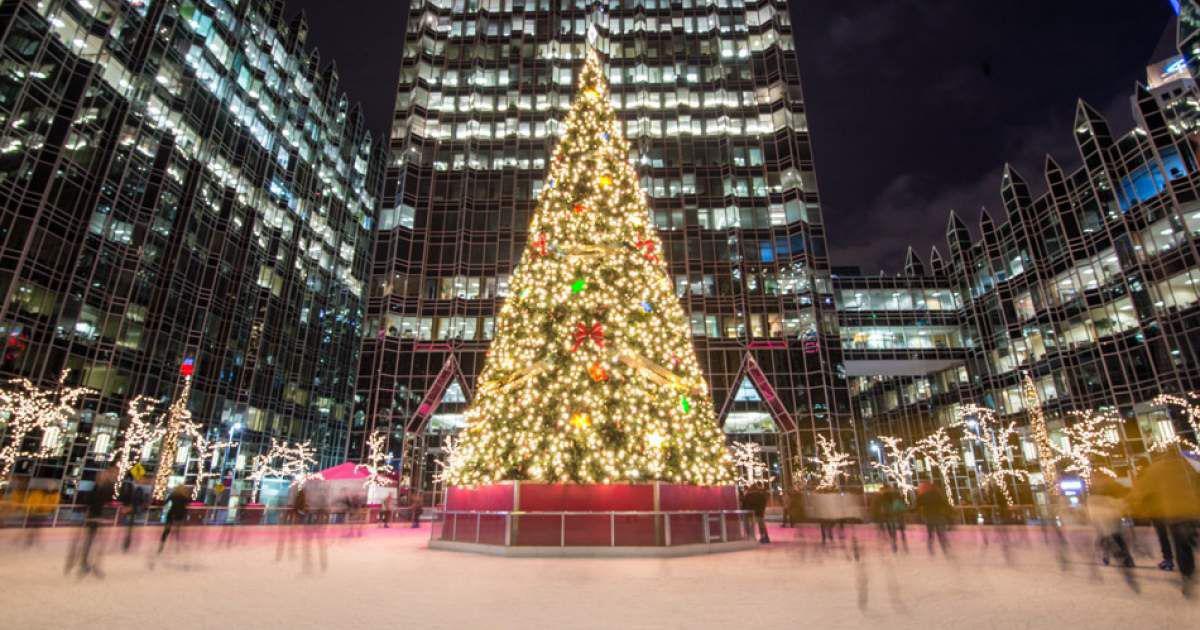
This was Pittsburgh’s 61st Light Up Night but for a group of teenagers this was their first.
“It’s beautiful out here,’’ Nyja Bradley, 19, of Pittsburgh said. “I love being out here with my friends where we all can celebrate our first Light Up Night together.”
Food vendors with local products were lined up on the street providing amazing things for people to buy.
“The Christmas market is my favorite. There’re so many fresh foods to choose from.”
Nyja wasn’t the only loving the Christmas market. Many families could be seen waiting in lines to buy hot pretzels, sugared almons, fresh
popcorn and so much more.
Danielle Fox, 19, of Pittsburgh, was with Nyja during Light Up Night. “I have never seen anything like this. So many people clustered together but still having a good time.”
Danielle was right, thousands of people showed up Downtown and you had to squeeze through people to get anywhere.
Nontheless, memories were made as fireworks shot off into the sky and children could be heard screaming with joy. November 19th was a night for everyone in Pittsburgh to remember.
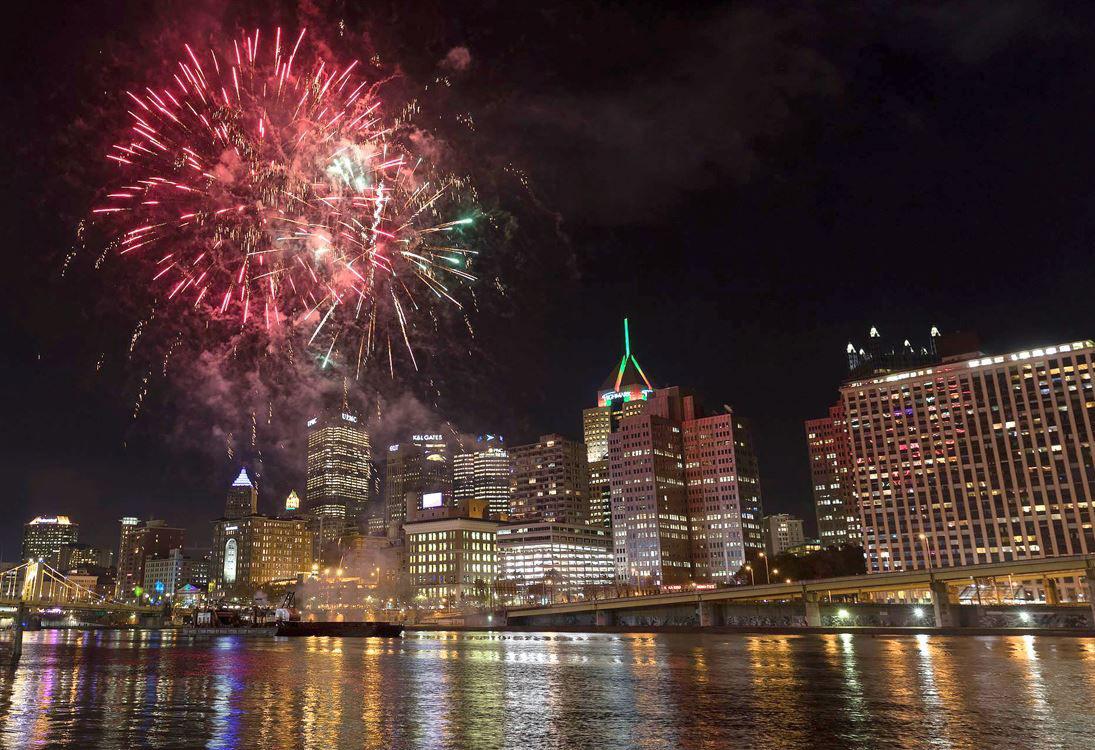
“It’s beautiful out here and you can feel everyone enjoying it together. I love being out here with my friends where we all can celebrate our first Light Up Night together.”Above: Dazzling fireworks light up the Burgh. On left: The UPMC Rink at PPG Place in the heart of downtown Pittsburgh features a 66 foot tall tree illuminated by more than 100,000 lights. The ice rink is larger than the one at Rockefeller Center, New York City
November 19th was a night for everyone in Pittsburgh to remember.
“Life today is nervous, sharp and zigzag. It often stops in mid-air. That is what I aim for in my dances.”

–MARTHA GRAHAMMartha Graham, photo by Angus McBean, copyright Harvard Theatre Collection, Houghton Library.
PERFORMING ARTS / PITTSBURGH AND DANCE
By Delaney Makey Multimedia majorIHAVE BEEN FASCINATED with dance since the first time my mother put me in a leotard and walked into a dance class. Ever since I turned two years old, I have taken dance lessons. My entire life, I have been on different competitive dance teams and in multiple shows that required many hours of exercise.
After graduating from high school, I wanted to connect my professional plans with passion for dance, which led me to join the competitive dance team at Point Park University.
Making this decision was easy. Known for its yellow steel bridges and beautiful skyline views, Pittsburgh is widely regarded as one of art capitals of the United States.
A largely respected and enjoyed art form in the Steel City is dance, deep-rooted in Pittsburgh culture. When you think of Pittsburgh and dance, the name of Martha Graham, a visionary of modern dance, first comes to mind.
Graham was born in 1894 in Allegheny City, which in 1907 became a part of Pittsburgh. When she was growing up, dance was still mostly interpreted as folk or social dancing in the community, or vaudeville on popular stage, with full ballet productions being rare spectacles. At the same time, Loie Fuller, Ruth St. Denis and Isadora Duncan were already busy breaking old conventions by emphasizing natural movements and emotional sincerity and thus establishing modern dance as we know it.
It fell onto Martha Graham and other American dancers and choreographers to propel modern dance into a flourishing art form in the United States.

An art form or a sport, dancing allows for creativity and passion that is completely unique.Janet Eilber, principal dancer with the Martha Graham Dance Company, performs “Lamentation” choreographed by Martha Graham.
 Portrait of Martha Graham, by Nicholas Muray, 1922.
Portrait of Martha Graham, by Nicholas Muray, 1922.
Often called the “Mother of Modern Dance,” Graham summarized the essence of her art as trying to reflect on time she lived in:
“Life today is nervous, sharp and zigzag. It often stops in mid-air. That is what I aim for in my dances.”
And she meant it.
Graham has choreographed over 180 ballets and become a renowned dance master. Dancers around the world study the so-called Graham technique including floor and centre work and certain traveling steps and sequences to develop spatial awareness.
The Martha Graham Dance Company is the oldest dance company in existence in the United States. Launched in 1926, the company originally consisted of only women but then opened to everyone. Until this day the company maintains a strong commitment to inclusion.
The TIME Magazine bestowed onto Martha Graham an honorary title of the “Dancer of the Century.”
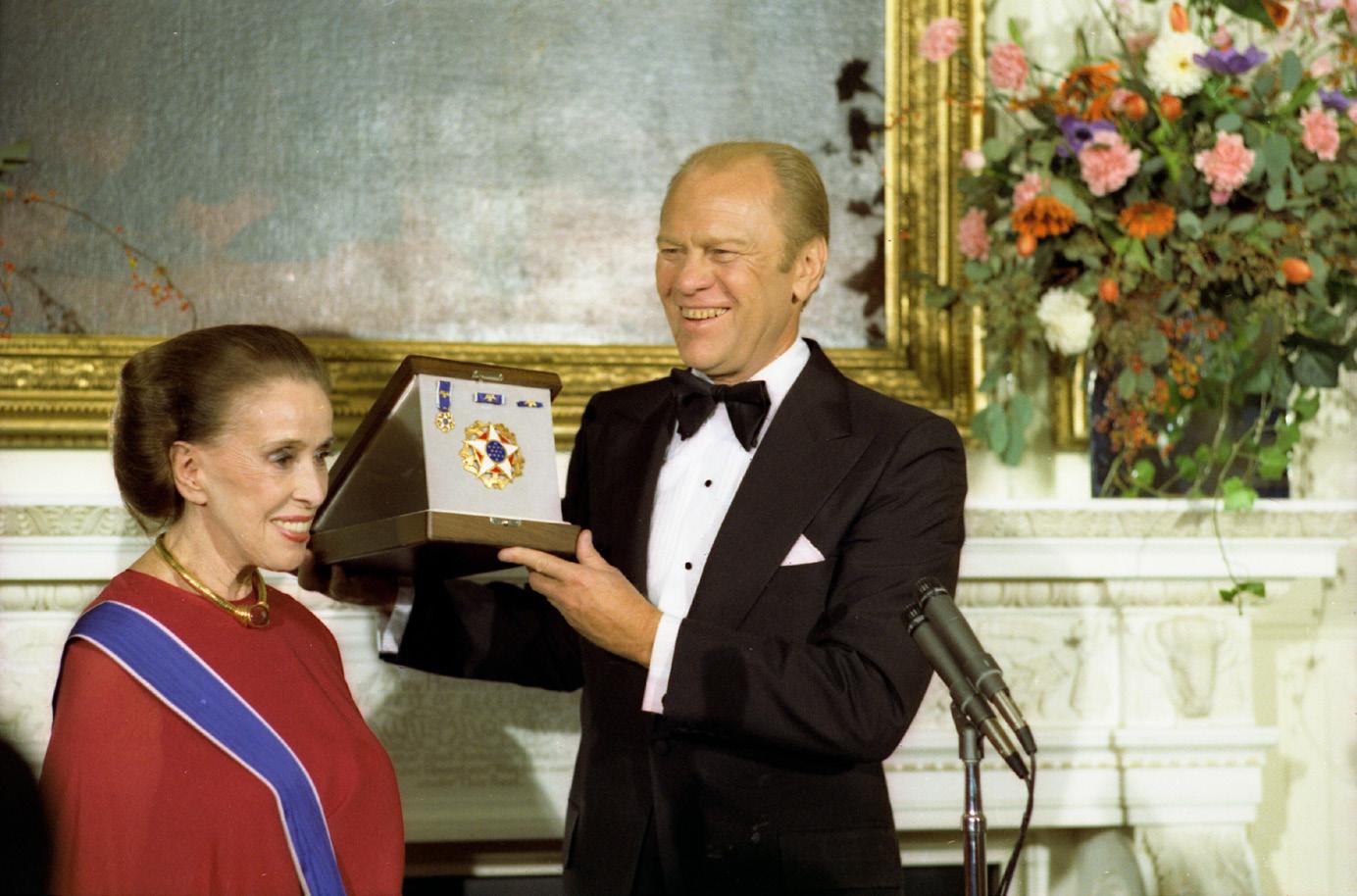
Another iconic figure in the Pittsburgh terpsichorean community is Eugene Curran Kelly, an innovative dancer and choreographer better known to the world as Gene Kelly and the inventor of cine-dance. He was born in 1912 in the Highland Park neighborhood of Pittsburgh.
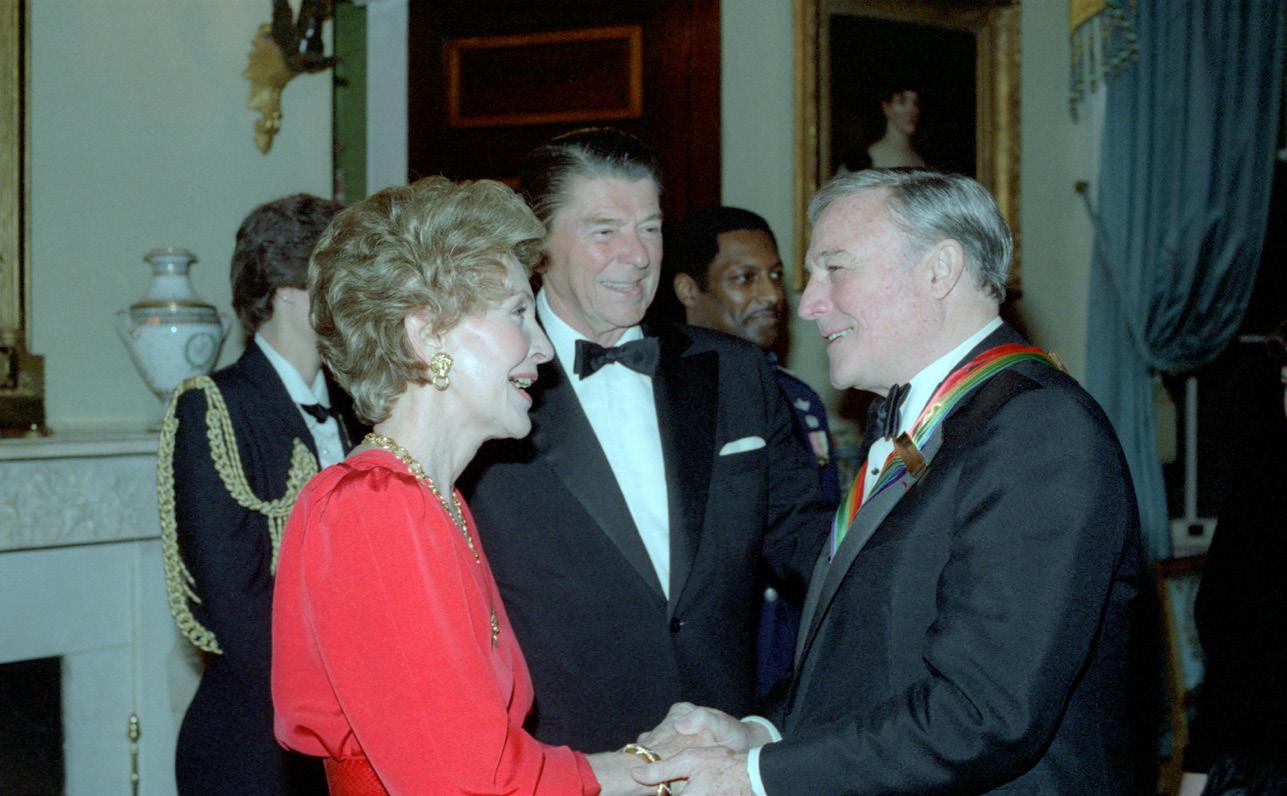
If Martha Graham revolutionized dance on theatrical stage, then Gene Kelly did the same for dance on the screen turning motion pictures into a stage.
Gene started taking dance classes with his siblings when he was seven but dreamed about playing sports There was a reason for that. His younger brother Fred reminisced:
“We three little boys (James, Gene and Fred) would leave home for dancing class dressed up beautifully, and we’d come home in rags. Dancers were thought of as sissies, and the neighborhood guys would lay in wait for us. Jim was very tough and he’d fight, or Gene would start the fight and Jim would finish it. Jim was our protector. But it was sort of our daily routine. Fighting, that was the style in Pittsburgh in those days.”
Gene’s mother, Harriet Curran Kelly, in 1921 started the Five Dancing Kellys, a family vaudeville act in which her two daughters and three sons sang and performed dancing routines. They appeared at different amateur nights. When nationally
“Someone once described Gene as having an American baseball personality and I think that’s just about right. He’s a talented dancer, singer and actor, choreographer and director, and a man I personally admire. As a boy, he saw himself as more of a football player and went to his dancing lessons under parental duress. But by the time he was in college, he had founded a dancing school and after graduation tried his luck on Broadway. … Gene isn’t dancing much anymore, but he’s encouraging promising young dancers to develop their talent. And his legendary accomplishments are ours to enjoy at the turn of a reel or by closing our eyes and remembering. … Bob Hope used to say that every time Gene Kelly dances, Fred Astaire starts counting his money. [Laughter].”
renowned Seven Little Foys did not make it to Pittsburgh because of bad weather, the Five Kellys fit for them in several charity events.
In 1929, Gene graduated from Peabody High School, currently Pittsburgh Obama, where he was on football, basketball and hockey teams. He went on to Penn State College to study journalism, but economic depression brought him back home and after a while he resumed his studies at PITT.
His father lost his employment and Gene took on every job he could find to pay the tuition, including digging ditches. He formed a dance duet with Fred, which they called the Kellys Brothers and performed in local nightclubs.
In 1931, his mother took over a dance school in Johnstown and turned it into a family business. That is how the Kelly School of Dance with Gene and Fred as dance instructors was born.
At those days social dancing gave youths an arena to communicate, establish emotional connections and convey feelings. In simple words, knowing how to dance was important, and it can be compared to knowing how to navigate social media today.
The legend says that Gene Kelly would teach the next day to his students everything that he observed in nightclubs, musicals and vaudeville shows. Gene taught dance for six years, confirming that an effective way to master something is to teach it to others. The school became a success, was renamed as the Gene Kelly Studio of Dance and added a new location in the Squirrel Hill neighborhood.
After earning a degree in economics, Gene enrolled into the University of Pittsburgh’s Law School. His plans to study law did not materialize, but the world received a star entertainer who sent a powerful message that everybody could dance.
Before his stardom, Gene Kelly not only became a well-known dance instructor in Pittsburgh, but also tried himself as a choreographer and director. While still giving dance lessons, he began staging shows, including at the Pittsburgh Playhouse, a civic
theater company at the time and currently Point Park University’s performing arts center.
In spring 1938, Kelly choreographed and danced in “Hold Your Hats” musical revue at the Pittsburgh Playhouse. Later in the year, in August, Gene went to New York City to conquer Broadway and the rest is history. Looking back, he once said, “I wanted to dance for the working-class guy. Those were the parts I was fitted for—the sailor, the truck driver, those repairmen.”
Dance culture continues to thrive in Pittsburgh and the legacy of Martha Graham, Gene Kelly and many other outstanding performers is carried on in the dance community. Multiple theatrical venues and events provide dancers with the opportunity to showcase their work in amateur and professional settings.
This includes Point Park University, which is home to a B.F.A. in Dance at the Conservatory of Performing Arts (COPA). It is among the leading dance programs in the country providing concentrations in ballet, jazz and modern dance.
According to Tatum Tucker, of Columbus, Ohio, a student at Point Park University’s COPA who is pursuing a B.F.A. in Dance with a jazz dance concentration, “Point Park has a very inclusive program with very talented dancers. The instructors are very inspiring to learn from and clearly have a large knowledge of the dance styles they teach. I feel like Point Park is one of the best places to get a well-rounded dance education.”
The love for dance is widely shown throughout the achievements of COPA dance program’s alumni which inspire a new generation of dancers to follow in the footsteps.
For example, Dara Schlesinger, class of 2021, is company member with Mareck Dance, formerly Missouri Contemporary Ballet.
Maya Bowles, class of 2020, has made her Broadway debut as a performer in “Moulin Rouge! The Musical. ” Dustin Wolf, class of 2018, has gone on to choreograph dances for Netflix and Disney. Colin Jacob, class of 2015, is company dancer with Richmond Ballet and had danced with Columbia City Ballet and Ballet Virginia.
One can say that Pittsburgh has a rich history of dance that goes beyond coincidences. Whether native or adoptive, many Pittsburghers go on to become successful professional dancers or they simply keep a passion for this mesmerizing art form. What is clear, the Burgh is the inclusive place to celebrate dance in its many forms.

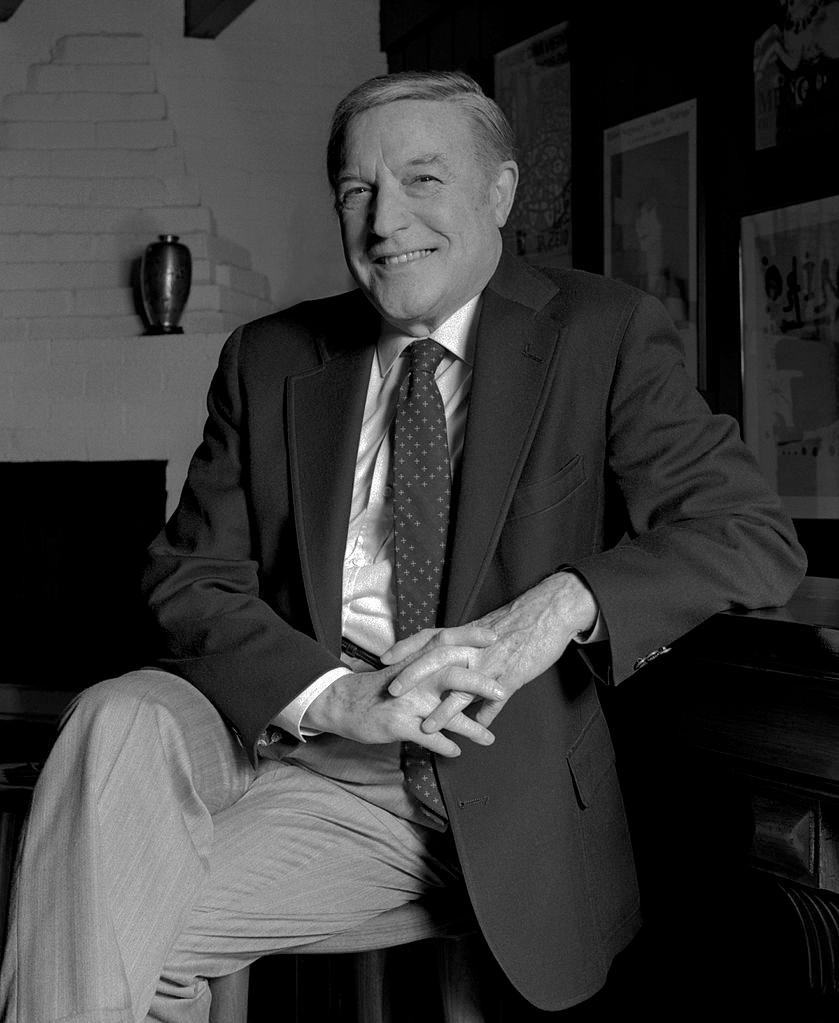
“I wanted to dance for the working-class guy. Those were the parts I was fitted for—the sailor, the truck driver, those repairmen.”
– GENE KELLYGene Kelly at 88, photo by Michael Allan Warren.
NOT EVERY BOOKSHOP in Pittsburgh lands on the pages of the New York Times. This
is simply because the Big Apple has near 100 of its own and according to IBISWorld the overall number nationally is around 10,000 Yet, in August 2019 the Gray Lady published a story about Eric Ackland and his store in Pittsburgh.
There were predictions that first big chains and then Amazon and other online retailers would phase out independent book sellers from existence.
Another foretelling was that in the digital age people would stop turning pages and start scrolling instead. Somehow it did not work that way and in recent years near 300 indie book ventures launched countrywide.
It takes passion and love of literature to start an indie bookshop. That was the atmosphere I felt when I went into one of the two storefronts of Amazing Books and Records on Forbes Avenue in Squirrel Hill with their huge offerings, from philosophy to graphic novels and from classic rock to electronica.
My eyes peered around the shelves until I found a section of works to explore more intently. These literary works were on a wide variety of subjects, from novelettes from Anaïs Nin, a visualized memoir by Marjane Satrapi, to a guide on how to write imaginative fiction by Jeff VanderMeer. I felt a sense of comfort wash over me as I browsed amongst similar minded people.
Small Business / FINDING COMMUNITY IN AMAZING BOOKS AND RECORDS
T here’s a story behind every small business in Pittsburgh that brings people together. Eric Ackland’s indie bookstore is rooted in passion and love for literature.
By Alexa Shaulis Broadcast production & media management majorPittsburgh’s small business of Amazing Books and Records, with two locations in Squirrel Hill and downtown Pittsburgh, is a great place to find an old literary work or record.
Eric Ackland, 50, owner, acquired the business that would then become Amazing Books and Records in 2013.
“I had gone Downtown to go to the DMV, but they were closed, so I went to a bookstore nearby called Awesome Books,” Ackland said in an interview, “and I mentioned how I had worked in a bookstore like this and at one point had been thinking about opening one. He then said it was for
sale, and I bought it and opened the store a month later.”
Both locations have a plethora of readings, with over almost 15,000 used books that can be bought online as well. Amazing also offers a deal where the customer can get a free book or record of their choice with every three that they buy.
Amazing not only sells books and records but also buys them. From the moment you walk into the store, you immediately feel welcome, whether that be an associate striking up a conversation or helping you find something, or from the large sampling of
SQUIRREL HILL AND DOWNTOWN locations offer their own unique experiences, from the store layout to the selection of music and literature that they have, though both shops will give you a free book or records for every three that are bought.
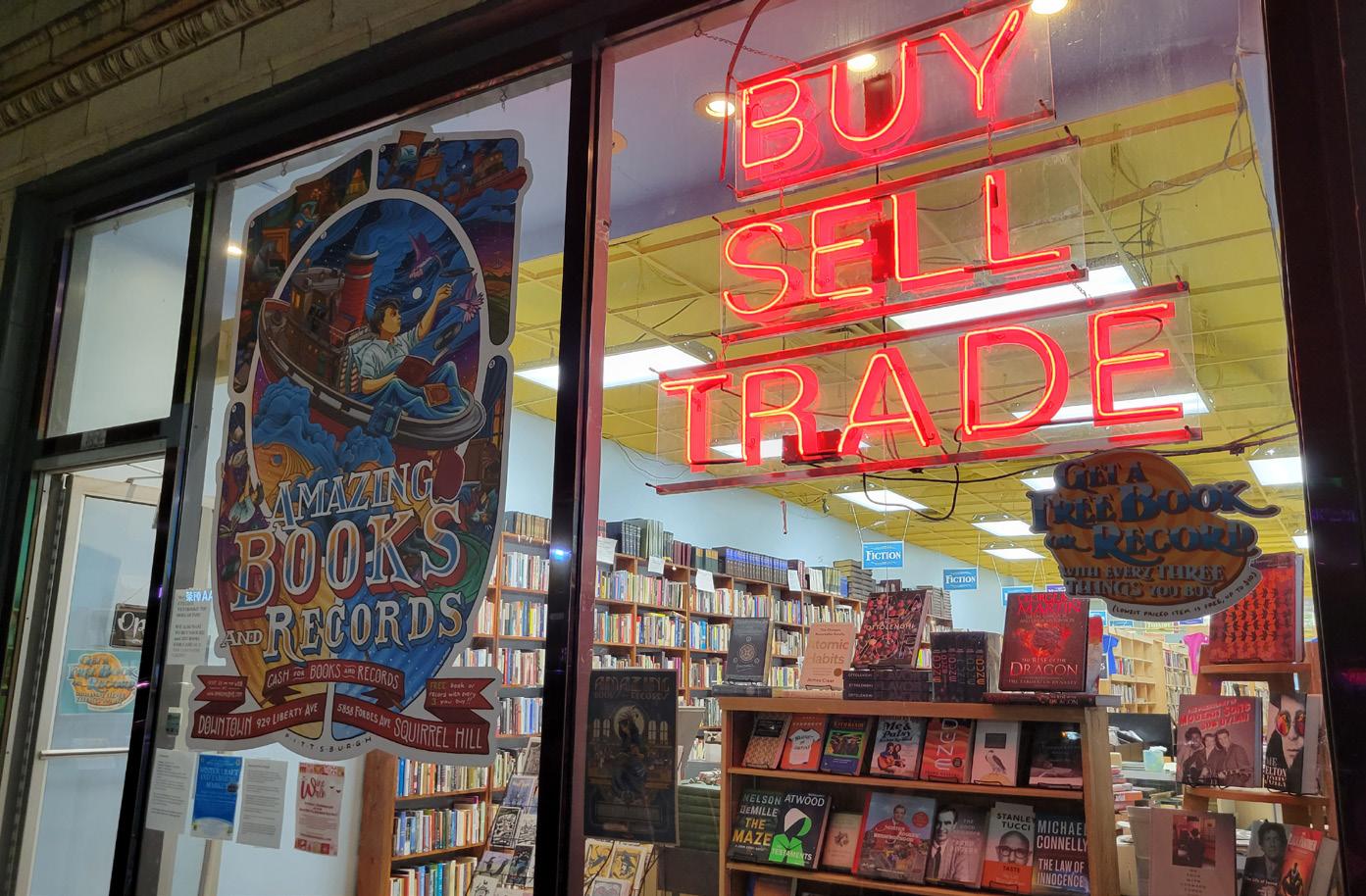
works or records you can enjoy.
The store has backed the local community of Squirrel Hill in many ways. Aside from book fairs and various in-store events, it provided support to Community Day School, Hillel Academy of Pittsburgh, Yeshiva Schools of Pittsburgh and Pittsburgh Colfax K-8.
Community is a big aspect of life in Squirrel Hill and Amazing helps to hold the neighborhood together.
“I wanted to make a space people would enjoy, that would bring serendipity, and where they could find things you wouldn’t find otherwise,” Ackland said.
Before I interviewed Eric, I saw him chatting with other customers and helping them find what they were searching for or wanted, displaying a plethora of knowledge on everything that they were looking for or discovered, learning from everyone’s interests along the way.
It may be a cliche to say that everybody has a different story to tell, but here it rings as very appropriate.
“My goal for Amazing Books and Records is to be amazing and to be a fun place for people to be at,” Ackland said.
AMAZING BOOKS AND RECORDS
offers a wide variety of items at both storefronts, as shown in photos taken from photographer Alexa Shaulis during her visits to the shop.
I have always gravitated to stores that I could easily lose myself in, just absorbing in the atmosphere of the place as I browsed around, looking for that perfect item to get, and that’s what I found in Amazing Books and Records.

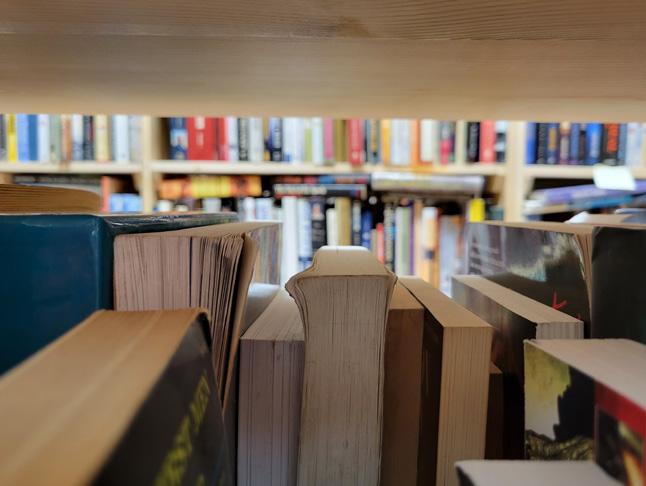

“I wanted to make a space people would enjoy, that would bring serendipity, and where they could find things you wouldn’t find otherwise.” – ERIC ACKLAND
Around the City / PITTSBURGH BREWS
In a city bursting with incredible places to wind down with a cup of joe, let’s take a look at some of the more eccentric coffee shops Pittsburgh has to offer.
By Samantha Hindman Multimedia majorTHE HUSTLE AND BUSTLE that people experience in everyday city life can all trace to one common remedy: a cup of coffee. Many people use their morning coffee run as a way to unwind before their hectic day at work, class, or fulfilling other obligations.
Typically, when you think of a coffee shop, the standard coffeehouse chains come to mind. But here in Pittsburgh, there is an array of whimsical and unique hidden gems that can turn a simple cup of coffee into a memorable experience. Though there are plenty to pick from, here are a few standout favorites.
BLACK FORGE COFFEE
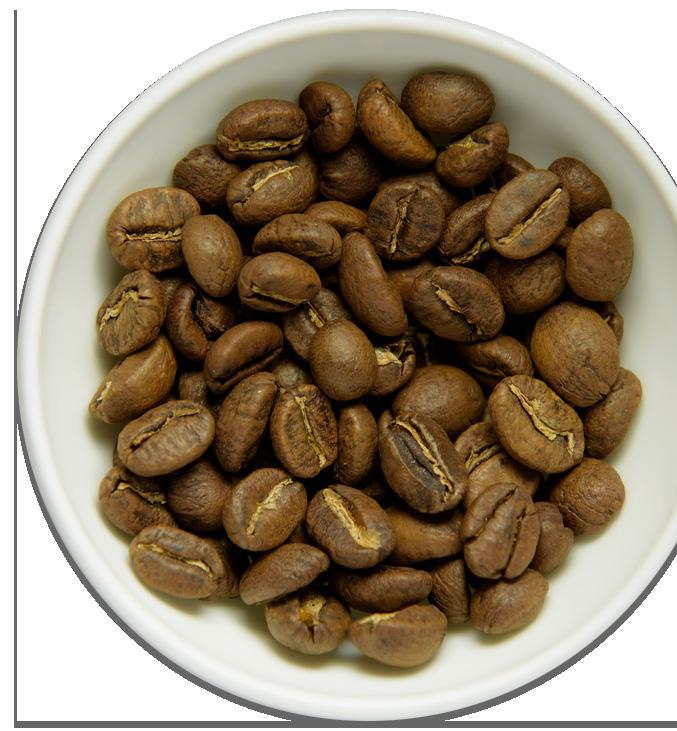
When you think of a coffee shop, does the occult come to mind? How about a concert venue? Skulls, punk-rock and death? At Black Forge, these elements are central to both their brand and their product, making a stop here certainly worth the scare.
“Black Forge is so unique, because it isn’t just a place to get coffee, it’s a whole experience,” says Luke Mongelli, Point Park University student and member of the band Dead Sin, which has attended Black Forge as a concert venue many times in the past. “It’s really cool to have the band play there, because it’s grungy and it’s a really intimate space.
Not to mention, the beverages at Black Forge also have names to go along with their cultish theme - take the Hellhound latte, for instance. To top it all off, every drink on the Black Forge menu costs the customer a total of $6.66, a ghoulishly clever touch.
THE HOP ALONG CAFE
This coffee shop is a standout as the first ever bunny cafe in the U.S. Having just opened in November of 2022, this shop is the newest addition to the city on this list.
The Hop Along Cafe is a proudly LGBTQowned business located Downtown, and it features an array of furry friends that you can snuggle and cuddle with while you enjoy your beverage. Intended to shed more awareness onto the number of bunnies in shelters, all of the animals that are housed in the cafe are adoptable and a portion of profits made at the cafe goes to a Pittsburgh animal rescue, “Buns of Steel.”
So, for a cafe experience that will make you positively jump for joy, head on down to the Hop Along Cafe and check it out for yourself.
THE BLACK CAT MARKET
While animal-themed cafes are becoming a popular trend, there’s no place quite like Lawrenceville’s Black Cat Market, an appointment-based experience where there’s no shortage of coffee, cats and community.
In Pittsburgh, there is an array of unique hidden gems that can turn a simple cup of coffee into a memorable experience.
This cat cafe boasts over 650 adoptions since its opening, with more each and every week, creating a deep dent in the number of feline friends currently waiting to be adopted in shelters.
In addition to their normal activities, the cafe also hosts several events throughout the year to help spotlight local artists. Using a portion of the proceeds to help local animal rescue groups, the cafe takes its role as an aid to animal rights activism very seriously.
DELANIE’S COFFEE
This South Side coffee spot is locally known for its incredible flavors, array of organic and dietary-restricted options and absolutely gorgeous layout and decor.
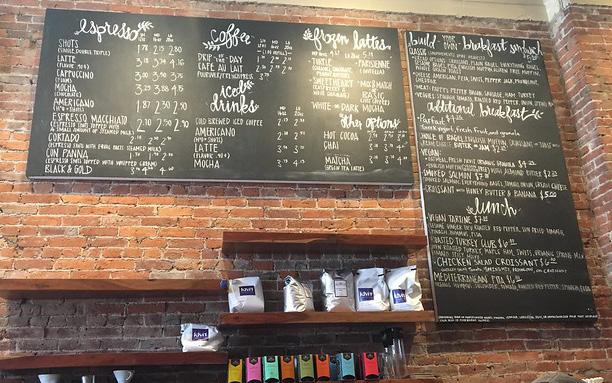
A highlight of the shop is its second-floor, containing a bookshelf full of classics, several lounging sofas and a generally cozy atmosphere for anyone to enjoy. If you’re trying to find a quiet nook to study, or a cute date spot with a casual vibe, Delanie’s is the place to be.
GASOLINE STREET COFFEE
If a rustic and hipster vibe is what you’re searching for in your next favorite coffee shop, look no further than Gasoline Street Coffee. This coffee spot was created out of an old Gulf gas station, making the destination an iconic stop in your Downtown ventures.
Gasoline Street has been open for several years and has a stage that often hosts live musical performances. The spacious coffee shop has a large, accommodating seating area, as well as several games and activities for guests to enjoy during their visit.
The eccentric premise and decor of the shop is enough to hook any customer into a second visit, but that isn’t all they have to offer. Enjoy their variety of unique flavors, special events and massive beverage selection during your next visit.
Delanie’s is the place to be if you’re in South Side. If you’re looking for anything from lavender to chai, this place is guaranteed to hit the spot every time.
Delanie’s coffee menu is extensive to fit a variety of tastes and lifestyles.
Food Corner / DOWNTOWN PITTSBURGH BY THE SLICE
Ever wonder where to get a good slice of pizza in downtown Pittsburgh? We went around to some of the top-rated pizza joints and gave them a shot.
By Dylann Yarrington Broadcasting majorWHEN YOU aren’t a Pittsburgh native, it can be hard to know where to go to get a good slice of pizza in the city. That’s why I took the liberty of hitting the streets and finding great pizza joints in downtown Pittsburgh.
Here are three of the best-rated pizza places, Genoa’s Pizza and Bar, Mama Lucia’s Pizzeria and Papa Allen’s Pizza.
GENOA’S PIZZA & BAR – MARKET STREET
This staple downtown pizza joint was one of my favorites. Local college students rave about Genoa’s, so it was a no-brainer that this place was on our list.
When you walk into Genoa’s, you feel at home. It’s your typical, local, pizza joint. It has a dining area, bar area and televisions throughout. The process to order was quick and easy. Around the corner is the counter where you order, then find yourself a seat, and staff bring it out when it’s ready.
The pizza was greasy, cheesy and delicious. Upon first bite, you get a savory red sauce, thin layer of cheese, fresh pepperoni and a crispy crust, Genoa’s was the best pizza of the group. For two slices of pepperoni pizza and a soda, you pay $10 (plus tip if you wish).
Overall, Genoa’s had the best flavor and best atmosphere. Genoa’s Pizza and Bar is officially rated an 9/10.
MAMA LUCIA’S PIZZERIA – WOOD STREET
Mama Lucia’s Pizzeria was one I heard a lot about and was excited to visit. However, I was mildly disappointed. There was construction right outside the door, which is not welcoming for patrons.
When you walk in, you go up to the counter, order your pizza, grab a soda and sit down. The employees were really friendly, but it seemed as though they were a little busy in their own world. The napkin dispensers were dusty, which means they don’t clean very thoroughly during their shifts.
The pizza was a cheesy, greasy mess which isn’t necessarily a bad thing. The crust of the pizza was slightly burnt but tasted better than Genoa’s. The sauce was a little on the sweeter side, so beware of that when going here.
All of that in mind, the price was reasonable, especially for the local college students. It was less than $10 for two slices of pizza and a pop. Overall, the pizza itself was a 6.5, but along with the friendly staff it was a grand 7/10.
PAPA ALLEN’S PIZZA – SMITHFIELD STREET
Papa Allen’s was the least known of the three. Although the price point was good at $10 for two slices of pizza and a pop, there was still something that affected my rankings.
After you settle with your choice of topping, your order is taken to the back. Your pizza gets topped, then brough out to the table. This New York-style cheese pizza was very greasy and very floppy. The sauce and cheese were great, but the pepperoni was not high-quality.
The service was friendly and the atmosphere was what one would expect of a small pizza shop. The pizza is a solid 6/10, but with the service and price, it was overall a 7/10.
Pittsburgh may be known for Primanti’s sandwiches and pierogies, but there are some great pizza shops around here too. This was just a few of the places I had the pleasure of visiting. If you’re heading Downtown, make sure to check out these friendly spots and let us know your favorite.

WRITER’S CORNER / MR. KOVACH
By Rain Yao Public relations and advertising majorMr. Kovach had lived at 215 Elm Street for about four decades. Some would call his home a bit ostentatious, but Mr. Kovach preferred it that way. He had collected numerous trinkets and knickknacks from garage sales and flea markets over the years. Although it could seem a bit pretentious, he believed the strange variety of things made it appear as though he had lived an interesting life. He proudly kept these souvenirs on a big shelf in the living room.
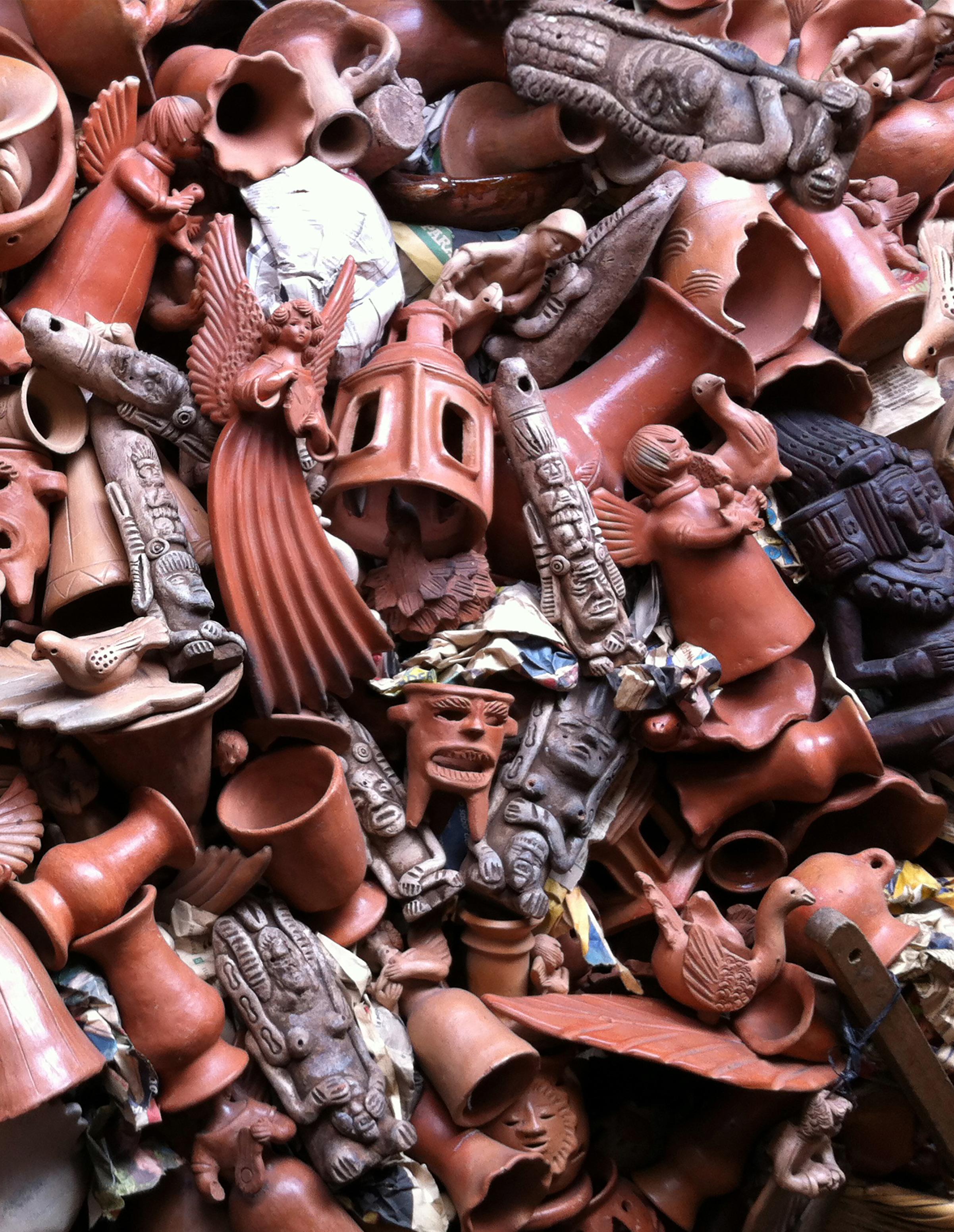
Mr. Kovach did not enjoy having guests and preferred keeping to himself. He did make an exception for his erudite neighbor two doors down, Mr. Archer. He considered Mr. Archer an excellent conversationalist. While they generally enjoyed each other’s company and were indeed good friends, they both had an argumentative streak that would occasionally flare up.
This evening was no exception as they began playing a game that should never be played between two players, Monopoly. If you have ever made this mistake, then you know the sort of trouble that lurked just ahead.
It was only the third time going around the board, but almost all the properties had been bought up by Mr. Archer at the beginning of the game.
Mr. Kovach was still holding out hope that he would somehow manage to land on both Park Place and Boardwalk, but at this stage of the game it looked doubtful that he would have the money to purchase them. Staring hopefully at the two properties, Mr. Kovach shook the dice and let them go.
Almost before the dice stopped, Mr. Archer shouted, “That’s eleven! That will put you on New York Avenue. I own the set, so it will cost you extra.”
Mr. Kovach glared askance at him, wanting to say something, but could only mumble instead. He counted out each of the bills needed to pay the rent and watched as Mr. Archer gleefully took up the flimsy Monopoly money, tucking it triumphantly under the board. Mr. Archer was close to Short Line railroad, one of the few properties Mr. Kovach had managed to get. He stared so intensely as Mr. Archer tossed the dice as if he could make them stop at 6, but it came back 8.
Mr. Archer loudly tapped his battleship playing piece on each space counting up to 8. He then laughed heartily saying, “Park Place! It’s Vacant, I will go ahead and buy it. I have plenty to spare at this point.”
“That’s it! That’s the last straw! You can’t possibly be this obtuse by accident!”
Mr. Kovach growled.
“Your just being petulant as usual,” retorted Mr. Archer.
Mr. Kovach had a bombastic tendency that Mr. Archer sometimes thought matched his eclectic memorabilia. It was in this spirit that he replied, “You are only saying so because you have a monopoly on all the properties on the board! You pin headed stick figure!”
Mr. Archer shouted, “That’s the point of the game!” He sprang to his feet, sending his rolling chair flying back into the wall with Mr. Kovach’s prized possessions. There was a sudden creaking sound, followed by a loud crash. Then a cloud of dust filled the room. It was accompanied by the noise of falling state mugs, the ping of souvenir spoons, the clack of breaking ceramic figurines, and the patter of wooden ornaments bouncing on the floor. Puffs of dust swept through the room like a pyroclastic flow until they reached the two men.
When the dust settled, both friends looked as though not only the ceiling but the sky was about to fall on them. Speechless for a moment, Mr. Archer wanted to offer an apology, but couldn’t find the words before Mr. Kovach began laughing loudly. Mr. Archer joined in nervously at first, but in no time both friends were clapping each other on the back in perfect mirth.
IMAGE CREDITS
PAGE 4
Map of Pittsburgh neighborhoods, by Tom Murphy VII, via Wikimedia Commons, public domain.
PAGE 5
Bloomfield Welcome Sign near the Bloomfield Bridge, by David Sallay, via Wikimedia Commons, public domain. Paul J. Sciullo II Memorial Park in Bloomfield, by Richard Stephen Haynes, via Wikimedia Commons, CC BY-SA 4.0.
PAGE 6
Protest march on April 7, 1968 from Hill District to Downtown three days after the assassination of Dr. Martin Luther King, Jr., by Charles R. “Chuck” Martin, via PITT Libraries, public domain.
PAGE 7
Mural detail at 2037 Center Avenue, Hill District, by Kyle Holbrook, copyrighted, used with permission; photo by 7beachbum, via Flickr, CC BY 2.0.
“Three generations for change” and “We are the change,” Pittsburgh Hope Mural paining in the Hill District in September 2008, via Barack Obama Flickr Photostream, public domain.
PAGE 9
A PRT bus wrapped with the new logo and teal-and-yellow color scheme, staff photo by Brandon Kurzawski.
PAGES 10-11
Pittsburgh’s Light Up Night, staff photos by Hannah Bond.
PAGE 12
Martha Graham, photo by Angus McBean, copyright Harvard Theatre Collection, Houghton Library, used with permission.
PAGE 13
Janet Eilber, principal dancer with the Martha Graham Dance Company, performs “Lamentation” choreographed by Martha Graham, October 14, 1976, National Archives, NAID: 30805967, unrestricted assess.
PAGE 14
Portrait of Martha Graham, by Nicholas Muray, published in “Shadowland,” September 1922, Vol. VII, N. 1, p. 16, via Wikimedia Commons, public domain.
PAGE 15
President Gerald R. Ford presents modern dance pioneer Martha Graham with the Medal of Freedom. October 14, 1976, National Archives, NAID: 6829647, unrestricted assess.
President Ronald Reagan and Nancy Reagan greet Gene Kelly in the White House during a reception for 1982 John F. Kennedy Center Honorees, December 5, 1982, National Archives, NAID: 75852533, unrestricted access.
PAGE 17
Photo of Frank Sinatra, Kathryn Grayson and Gene Kelly, from “Anchors Aweigh,” 1945, published in “Screenland,” April 1945, p. 23, Liberty Publications; via Wikimedia Commons, published in the U.S. between 1928 and 1963 and the copyright was not renewed, public domain. Gene Kelly at 88, by Michael Allan Warren, via Wikimedia Commons, CC BY-SA 3.0.
PAGES 18-19
Amazing Books and Records store, staff photos by Alexa Shaulis.
PAGE 20
Roasted coffee beans in white bowl, by Alorin, via Wikimedia Commons, CC BY-SA 4.0.
PAGE 21
Delanie’s menu, staff photo by Samantha Hindman.
PAGE 23
Papa Allen’s pizza, staff photo by Dylann Yarrington.
PAGE 24
Guatemala souvenirs, by PLBechly, via Wikimedia Commons, CC BY-SA 4.0.
BACK COVER, TOP 82 LINCOLN car on 6th Ave. crossing Grant St. in downtown Pittsburgh on June 27, 1965, by Roger Puta, via Flickr, public domain.
CALL FOR SUBMISSIONS
If you have story ideas, photographs, or multimedia, please let us know. Email burgh_inclusive@eml.cc.


